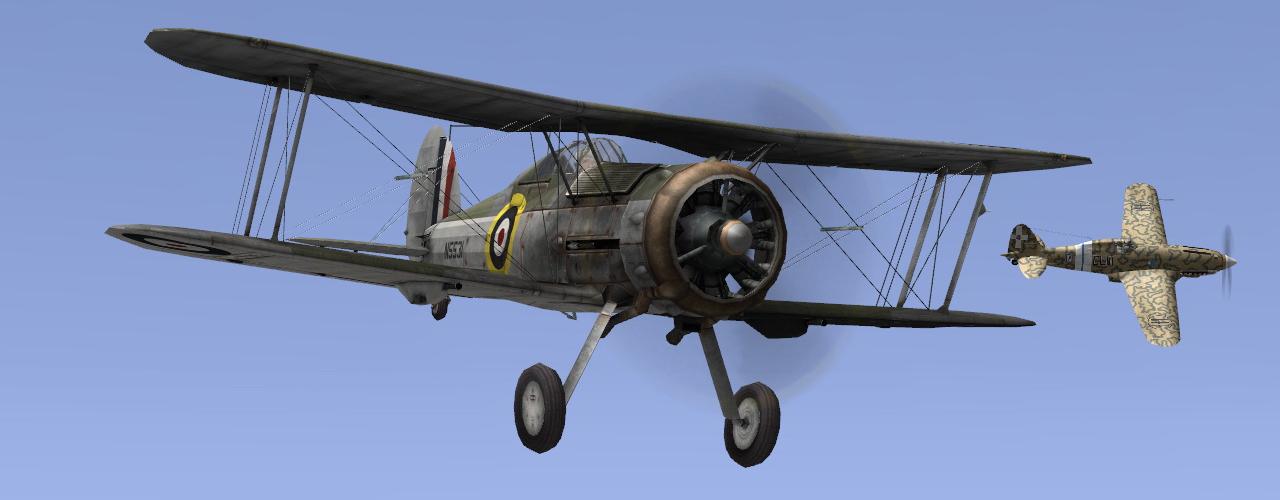It must be cold. Somewhere around 5,000 feet, in a cloudbank above a green swath of Central European countryside, you can feel the Gladiator shake and shimmy through a patch of rough air. You know that there will be rain when you dive through the belly of the clouds, visibility reduced to nothing only a few hundred feet off the deck. You punch the throttle open, and the Mercury engine roars, pulsing in your ears as you climb.
You know that they’re out there—hiding just behind a cloudbank, tantalizingly close- two enemy fighters, pilots flying hell-for-leather through the streaking clouds, out for blood.
When they finally appear, they’re right on top of you, whipping past in a hail of yellow tracer rounds. It’s an impossible anachronism—two other British Gladiators, but with German crosses etched on their wingtips. No matter. You fire bursts from your own guns as they wing past you, but they both slip inside another cloud as your shots go wide.
Down, you have to go down. You ease the throttle back, push your nose over and down towards the earth, the biplane’s wings corkscrewing as you plummet. You catch a glimpse of your adversaries as you finally punch through the cloud cover, pulling up sharply to avoid pancaking into a hill.
You bank hard as they fire, tracers whipping over the canopy. A round smacks into your wing, and the controls go mushy. You have to fight with the stick, kick the rudder over hard, but finally you turn and put one of the bastards in your sights, just as he corkscrews down away from you. You guess the deflection in a millisecond, pure instinct, squeeze the trigger and put a long burst where you hope he’ll be. What does it matter now if your guns jam? You see a cloud of bits spin off of his wing; you spit out another burst of machine-gun fire and watch as he twists into the ground, too low to bailout. One less Nazi.
But now your controls are gone, every input from the stick makes the plane veer over like it wants to bury itself in the ground. The engine splutters overheated from being jammed wide open for too long. With a final groan, it dies, the prop spinning lazily in the breeze. You hope the landing will be soft enough not to kill you.
You’ve got other problems. As you glide towards what you hope is a field, a hail of bullets whizzes over your wing. Looks like his friend is out for revenge. You rock your wings back and forth as the ground rushes up to meet you, trying desperately to stay alive. Just as you flair your wings, a burst catches your tail. You pancake hard, the wings disintegrating around you as you skid across the hard-packed earth. You bail, running across the ground to throw yourself down as the engine ignites and explodes in a haze of red behind you.
War is a hell of a thing.
It’s not an exaggeration to say that flight simulators were what brought me over to video games in the first place. Oh sure, I had a Super-Nintendo when I was young, and I have fond memories of playing Goldeneye on a friend’s N64 one weekend, but ultimately those were not the defining games of my childhood. Flight Simulators were.
Yeah, it didn’t help my social life.
But what set those games apart—whether it was Flight Simulator 95, IL2 Sturmovik (the original), or any other WWII-themed flying game pulled out of the bargain bin at the local CompUSA—was just how varied each playthrough could be. You sat down and drew up a basic mission, and literally anything could happen. I’ve lost count of the number of times I died within seconds of the game starting, whether from my own stupidity causing immediate aviation destruction and carnage, or from eagle-eyed AIs who could put a burst of cannon-fire directly into your pilot’s torso, blacking out the screen and killing you instantly.
Ultimately, the defining moments in flight simulators are your own experiences, completely randomized in each mission or scenario. Limping back to base with no aileron control to make a perfect three-point landing - “Did you see that?!” you shout excitedly to your wife/boyfriend/sister/cat, pointing to a rather dodgy-looking plane belching smoke at the end of a runway. A puzzled expression is the best you’re usually going to get in those scenarios.
When I started playing IL2 again in college, some friends and I tried to test a theory that a Nazi jet fighter (the first of its kind) had broken the sound barrier long before Chuck Yeager. It didn’t work—the plane exploded in midair like it had hit an invisible wall. So maybe we broke the game, but then again, flight sims really teeter on the edge of what we would consider a videogame. Microsoft’s Flight Simulator series will actually let you fly full airline routes across continents in real time with real-world weather conditions. I haven’t played one all the way through (yet).
If I’m making this sound easy, it’s not. Sims like IL2 probably have the sharpest learning curve of any game you’ll meet, outside of say, the original Half-Life. Learning the mechanics alone will often kill you—yanking the controls will usually send you into a spin and murder you. You’ll remember your first successful take-off, landing, and much much later, your first aerial kill. By the end of it, you’ll feel almost confident enough to fly a real plane.
Almost.


